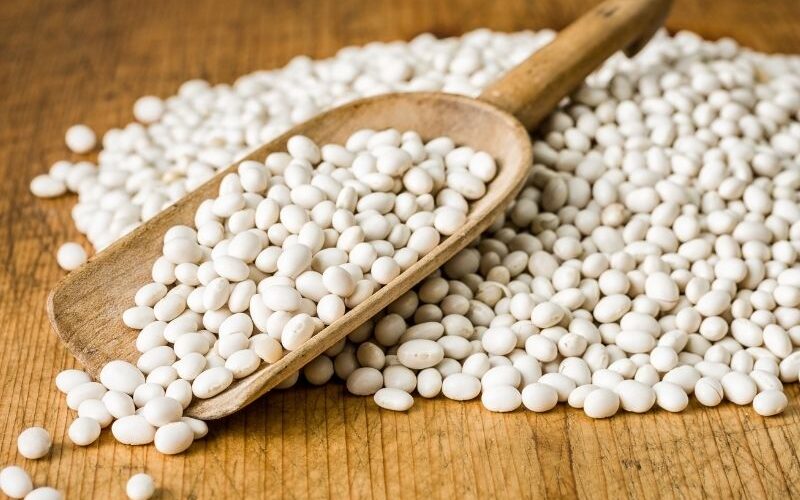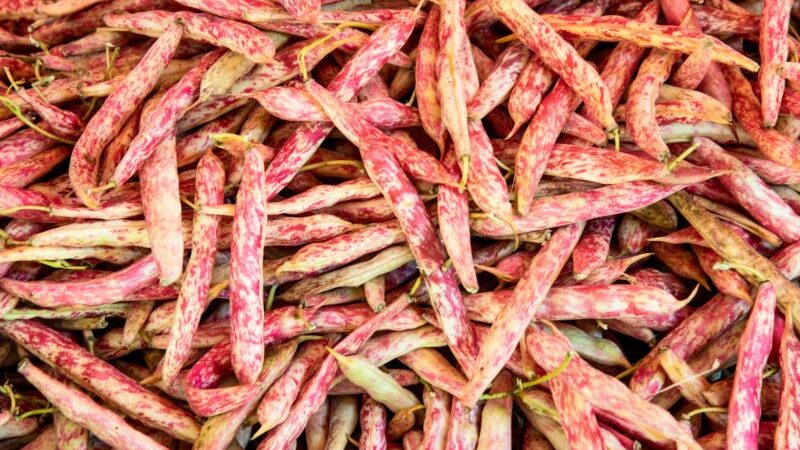Navy beans, also known as Haricot beans, come from the Phaseolus vulgaris species and are a type of white bean. Growing navy beans is a nice option for your garden soil and a great option to get a greater intake of protein in your diet by adding some small, delicious mild flavor beans.
They are way smaller than cannellini beans and have a mild flavor such as great northern beans, which I personally believe makes them a good candidate for soups. To be fair, I like most of my beans in a soup with some rice (except kidney beans, they are too hard and I rather have them on chilies).
Anyways, in the next guide, I’ll share some tips on how to grow navy beans and what you can expect to see while growing them.

How to Grow Navy Beans
1- The soil needs to be rich in nutrients, start by giving it a good touch of compost
2- Plant the navy beans 1-1.5 inches deep when the temperature is between 70-85° F in air and 60° F in soil
3- Space bush beans varieties 3-5 inches apart in rows 2 feet apart. Meanwhile, space pole beans 10 inches apart in rows 3-4 feet apart. Pole navy beans planted in double rows should be spaced 10 inches apart and 1 foot in-between rows
4- Water the plants until the soil is moist soil but do not waterlog them. After taking the weeds (manually) place a nice layer of mulch.
5- The seeds will sprout in 1-2 weeks.
How to Grow Haricot Beans in Pots

As navy beans are shallow rooted plants, they are a very good option to plant in containers, as they won’t need too much space to grow.
Despite this, navy beans are usually harvested as dry beans, so they need to be left on the plant until they are dry and ready to be picked up.
This means that 1- You will need to plant navy beans in many pots to get a good sized harvest or 2- The amount harvested will not be as good as if grown in garden beds. If you still decide to plant them in pots, here are the instructions to do it.
To sow navy beans in containers, plant them 1 inch deep into the soil. You can use potting mix for the soil or just blend one for yourself by mixing 1/3 of compost, 1/3 of peat moss or coco coir and 1/3 of perlite or vermiculite. Just try to make sure your soil is in that Ph range of 6-7 that beans thrive for!
The pot should be about 12 inches in diameter and 10 inches deep. Here I’ll leave a link to amazon to acquire 5 gallon pots that work well to plant bush and vining beans.
It’s also important to have some draining holes ready in any pot that you use. As beans do not like getting “wet feet” as this could lead to root rot.
Soil
When growing navy beans, the soil should have a temperature of at least 60° Fahrenheit and have a Ph between 6-7. They can thrive in any soil but usually do better in clay or loamy soils and it’s very important to give the soil a nice touch of compost before planting them.
For the best results, navy beans should be located in a spot with full sun. If you are planting vining varieties, make sure to give a good use to the shadows produced by the pole beans and place crops that grow well in partial-sun.
Beans are a great crop to grow as their roots will take nitrogen from the air and place them in the soil they are growing, so it’s not really needed to add fertilizer to induce growth.
If you want them to grow faster though, apply a mid-season side dress of compost or use a kelp extract solution.
Mulching
As it happens with many other types of beans, mulching your navy beans is a good practice that will allow you to have a better success rate and harvest.
Before mulching, make sure remove all the weeds from your garden bed, preferably by hand as the tools could go too deep into the soil and damage the shallow roots of the navy beans.
Mulch it’s great to maintain the weeds away and will help the soil conserve it’s moisture and temperature, which will be very useful if you live in an area where they can get overheated during some days in the summer.
Support
When growing pole navy beans, it’s useful to make a trellis for the vining pole beans to grow.
There are different ways to trellis beans. A classic one is to plant some bamboo poles in a circle-shape and connect them at the top with a string in a teepee kind of form. If you are starting to plant navy beans for the first time this is a good, affordable idea.
Make sure to plant the bamboo poles at least 1 feet deep into the soil if you live in a windy area, as both the weight of the plant and the wind could make the bamboo fall in planted in the wrong way. In the case you start planting beans regularly, it might be a good idea to get an obelisk trellis.
Beans can also be attached to fences or arches, there is also a bean tower plant support.
If you plan to grow navy beans (or any type of pole bean) in double rows, you can do a trellis in a X type of form, here is an example:

Pest and Diseases
Click here to see some of the beans common pest and diseases.
Harvesting
Navy Beans will be ready to harvest in 85-100 days after they’ve been planted
If you harvest Navy beans as dry beans, take them pods from the plant when they get dry, in a kind of leathery form and the seeds rattle a bit.
There are a couple ways to harvest dry beans. The pods can be picked up by hand when they are ready and then opened to release the seeds, or you can place the seeds into a bag and, throw it against a surface for a while and the seeds will come out from the pods.
Despite this, in the second method some parts of the pods will be together with the beans so you will need to winnow your beans to “clean them”.

An interesting way to winnow your beans, is to place a basket on the floor and pour the beans into the basket while they pass in front of a fan. Doing this a couple of times should make the work easier.
Harvesting Navy Beans in Damp Conditions
If you live in an area with damp weather or with frequent raining, and you want to harvest some of the navy beans as dry beans, there are a couple actions you can take to make this possible.
Hang the plant and let it dry
A typical thing to do is to pull the plant early and hang it in the basement, a barn, or any other dry environment. Despite this, taking this approach may cause the plant to get moldy.
Another approach you can take is to take the immature pods directly and let them dry near a window ledge. As soon as they get their typical leathery color take the seeds out and finish drying them in a dry spot in your house or in a dehydrator.
Navy beans are a really good vegetable to add in soups and cooked as baked beans in other dishes. If you are interested in growing white beans, click here to see the different types of white beans and some of their characteristics.
And this is it! I hope this article was useful for you. I wish you a good season and a good harvest for you.



